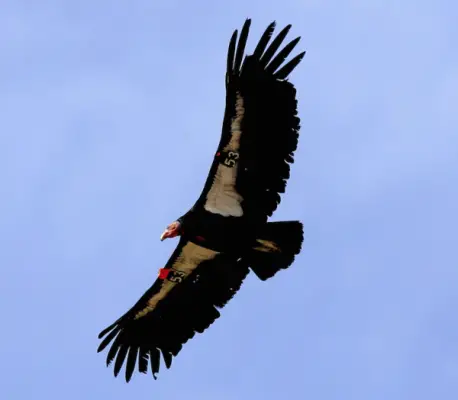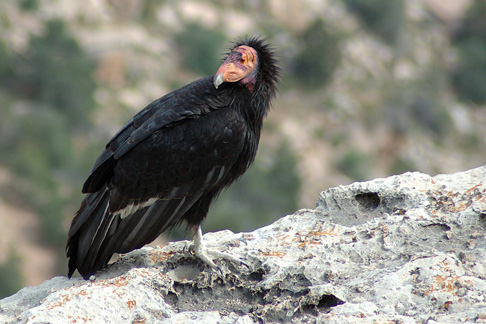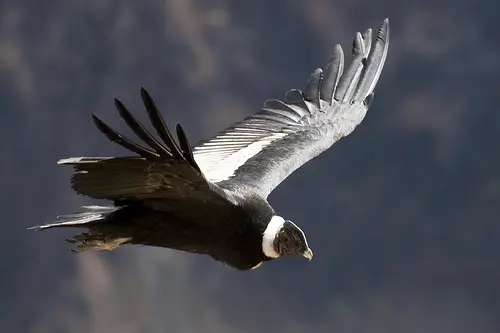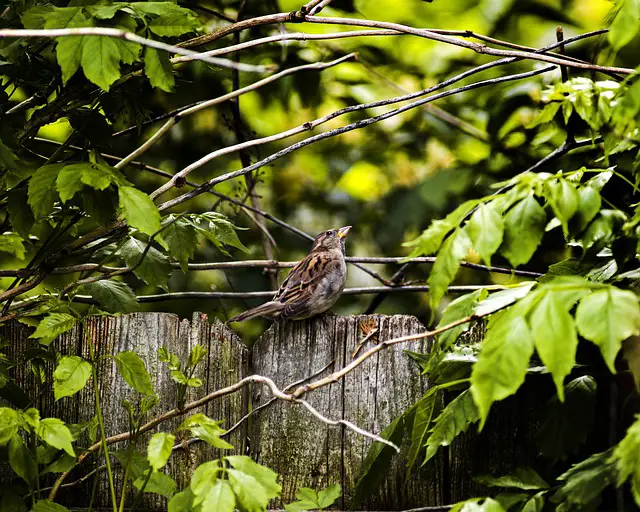The California condor (Gymnogyps californianus) is the only New World vulture to have survived to date but it is the rarest of the birds. The condor is the largest bird of North America. It was once widespread throughout the southern North America but now the range is reduced to northern Baja and British Columbia. The California condor is one of the birds that rely heavily on carrion.
California Condor Facts
Anatomy
- Adult California condors weigh up to 17–24 lb (7.7–10.9 kg) with the wingspan measuring up to 114 in (290 cm). The maximum wingspan measures about 3.05 m (10.0 ft). Many of these measurements are done in captivity.
- It reaches a length of about 46–53 in (117–134 cm).
- They have absolutely black plumage but the undersides of the wings show triangle of white feathers.
- Young condors are recognized by the greyish head while the adults seem to show reddish orange head.
- The color of the condor’s bill is ivory while legs are grey.
- The head and neck are nearly all naked with no hair. Its color varies from yellow to reddish orange depends on the mood of the bird.
- They are thought to produce few sounds such as ‘grunting’ or ‘hissing’. One cannot hear these sounds unless he/she is few meters away from the source.
Distribution & Habitat
- The historical range of California condors includes northern Baja and British Columbia. In modern times, they are introduced in the mountainous areas north of Los Angeles, Grand Canyon (Arizona), Monterey, and California.
- California condors are likely to live in a wide variety of habitats such as oak savannas, rocky shrubland, grasslands, coniferous forests, and coastal beaches. They typically use large trees or cliffs for nesting sites.
- They will travel 250 km (160 mi) to find carrion. Californian condors have a much greater range.
Read More: California Condor Facts

Behavior
- The California condor is extremely intelligent and curious bird. It gets to the food by noticing the behavior of other species.
- They may fly as much as hundreds of miles in a day to in search of carrion.
- Condors sometimes forage in groups and mostly alone. They typically fly in high altitudes.
- At high altitudes, they simply glide so much so that they sometimes do not flap their wings for miles.
- Californian condors fly at a speed of 90 km/h (56 mph) but at an elevation of 4,600 m (15,100 ft).
- They will roost on the highest point of perches because from that height condors could easily glide without wasting too much energy in flapping.
- The average lifespan of Californian condors is 60 years.
- They spend many hours in preening feathers of their counterparts.
Feeding Ecology & Diet
- California condors are primarily scavengers spending hours searching for large carcasses. As such they observe the activities of other animals. The California condor’s diet consists of marine mammals, domestic ungulates, and wild ungulates.
- They can tear apart even the hardest or thickest part of the skin with their powerful bill.
- Condors are likely to consume carcasses of land mammals such as donkeys, cougars, coyotes, deer, sheep, horses, bears, pigs, cattle, and rabbits.
- In marine mammals they eat California sea lions, salmon, and whales.
- They do feed on birds or reptiles but only sometimes.
- California condors lack the sense of smell as a result they rely on other scavengers (like eagles) to find carcass.
- Due to the large size California condors can drive away other animals from the carcass except for bears or golden eagles. In one or many occasions, golden eagles stand in the way of condors and carcass and sometimes they fight with each other.
- They may eat as much as 1–1.5 kilograms (2.2–3.3 lb) of meat in one sitting.

Reproductive Biology
- California condors reach the maturity age at 6 years. Soon after becoming mature they will start looking for the mating partner.
- A female condor lays bluish-white eggs in January to the end of April. Eggs average 280 grams (10 oz) in weight with the length reaching 90 to 120 mm (3.5 to 4.7 in) and they are 67 mm (2.6 in) wide.
- Condor’s eggs hatch in about 8 – 9 weeks. Both parents incubate the eggs.
- It takes 7 days for chicks to leave the shell and they are born with open eyes.
- Young condors are recognized by the grey down but the color fades away as the bird grows older.
- They will fly in about 150 – 180 days but remain with parents until the second year when they disperse.
- The only predators of condor’s eggs are ravens while young condors often fall prey to bears and golden eagles.
Conservation Status
There are 425 California condors remaining in the wild and in captivity. International Union for the Conservation of Nature has listed it as a critically endangered species.








